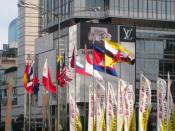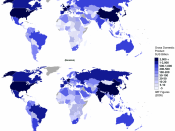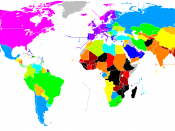Indonesia's economy:
Income and quality of life indicators
The can include a country's resource endowments, access to the sea, ethnic fragmentation, climate and legal systems.
Indonesia is the world's fourth most populous nation. The main religion in Indonesia is muslim.Like many other East Asian nations, Indonesia has evolved from an agricultural economy to one whose GDP is led by manufacturing.
Prior to 1967, Indonesia had been a closed economy, rejecting the West's offer of becoming an ally, however when General Suharto came into power, Indonesia opened itself up to the west by welcoming foreign investment, increase trade particularly in its oil and gas exports. Protection in the form of subsidies within its agricultural industries was introduced as Indonesia aimed to gain self-sufficiency in growing rice so as to lower rice imports.
Indonesia is also a mixed market economy in that it both regulates as well as participating in economic activity through State Owned Enterprises (SOE's) in main industries such as agriculture, manufacturing, trade, finance and mining to ensure that there is sufficient competition to ensure lower prices for the average Indonesian consumer.
Contrasts in levels of development
Indonesia is a developing economy, compared with Australia which is a high income economy. Similar to Australia, Indonesia has a wealth of natural resources.
May 25th 2004
From the Economist Intelligence Unit
Source: Country data
2000 2001 2002 2003
GDP per head ($ at PPP) 3,055 3,200 3,330 3,490
GDP (% real change pa) 4.93 3.47 3.69 4.10
Government consumption (% of GDP) 7.18 7.73 8.21 9.20
Budget balance (% of GDP) -2.80 -1.18 -1.60 -1.90
Consumer prices (% change pa; av) 3.69 11.46 11.92 6.59
Public debt (% of GDP) 102.41 88.98 78.11 72.90
Labour costs per hour (USD) 0.27 0.28 0.37 0.47
Recorded unemployment (%) 6.08 8.10 8.30 8.70
Current-account balance/GDP 5.32 4.82 4.31 3.80
Foreign-exchange reserves (mUS$) 28,502 27,246 30,969 34,962
Copyright é 1995-2001 The Economist Newspaper Group Ltd. All rights reserved.
Before the economic crisis of 1997/98 Indonesia had an average GDP of 7% for almost 30 years. During this time, real incomes had risen. In 1970, it was estimated 60% of the population lived below the poverty line. In 1997, this had fallen to 11% of the population. At this time Indonesia was ranked 11th in the world for its nominal Gross Domestic Product at Purchasing Power Parity rates.
The collapse of the Indonesian economy has saw export prices fall, and the value of the rupiah to lose three quarters of its value against foreign currencies.
Since this time, Indonesia's economy has slowly recovered. The current GDP being at 6-7%. Its GDP per capital is US$2,830 in 2002, adjusted for purchasing power parity. This, compared to Australia's $25,370 is much lower than developed countries. Australia's Current GDP lies at 3.8%.
The reasons for the differences between nations are as follows:
The different sizes in population.
Level of government support.
Level of growth
Time spent as an industrialized nation.
Income and quality of life indicators
18.2%, or 28 million living in poverty (defined by the World Health Organisation as living on less than US$1 a day). Its Human Development Index is currently ranked 112th in the world, and its GDP
International convergence
Indonesia was a founding member of the Association of Southeast Asian Nations (ASEAN). Created in 1967, ASEAN is dedicated to regional cooperation and stability. ASEAN also actively promotes trade and investment within ints members. ASEAN comprises Brunei, Indonesia, Malaysia, the Philippines, Singapore, Thailand, and Vietnam.
Cambodia, Laos, and Myanmar - the so-called "CLM countries" - presently hold observer status in ASEAN.
AFTA
Indonesia is committed to ASEAN's plan to create a free trade zone (ASEAN Free Trade Zone, or AFTA) by 2003. The plan envisions as much as 85 percent of the goods traded among ASEAN members will face tariffs of between 0 and 5 percent by 2003. By 2010, all tariff protection is to be removed.
ASEAN Regional Forum
In 1993, Indonesia helped found the ASEAN Regional Forum (ARF). Its objective is to accumulate new ASEAN member to confer on political-security issues. The ARF has created a regional security discussion forum, placing ASEAN at the center of these discussions. It is comprised of 21 members.
Nominally a free-trade area for more than a year, there is not much sign of economic integration in ASEAN
This divergence over trade pacts points to a deeper rift within ASEAN. Countries that already have relatively open economies, such as Singapore and Thailand, view the grouping as a means to increase the competitiveness of their exports, and so to attract more foreign investment. According to this view, the pooled natural resources, shared industrial base and collective consumption of ASEAN should give even China a run for its money. The investment, by and large, would still come from beyond ASEAN, and most of the goods produced would end up overseas too.
But formally, at least, ASEAN is designed to promote trade and investment among its members, not with outsiders. Thus the six old-timers, for example, have agreed to accord one another's citizens the same rights as domestic investors by 2010, but will not grant outsiders equivalent treatment until 2020. In fact, the reverse would be much more useful. No wonder the likes of Singapore and Thailand are concentrating on their own market-opening measures--depriving ASEAN of its best integrators in the process
Environmental consequences
In Indonesia the natural environment is deteriorating on all fronts. The Asian financial crisis of 1997 and 1998 worsened Indonesia's environmental problems. In an effort to try to rejuvenate local enterprises, Indonesia set aside its regulations on industrial behaviour. This resulted in local firms to take up cheaper yet more environmentally damaging production and harvesting methods. Due to inefficient energy use, there is increasing air pollution, this has a serious impact on public health. The deforestation that results from unregulated logging has been closely linked with floods and landslides.
Trade investment and transnational corporations
In 2002 merchandise exports (fob) rose by 2.5% year on year to US$59bn and imports (fob) rose by 2.8% to US$35.7bn, resulting in a trade surplus of US$23.1bn. At the same time the deficit on the invisibles and transfers account remained unchanged at US$15.6bn, leaving a current-account surplus of US$7.5bn.
The Indonesian Government implemented gradual changes to reduce its trade barriers, to promote trade liberalization since it opened its market up to the west.
Between 1986 to 1996, twenty policy packages were delivered to deregulate trading industries . This included quotas and import licenses converted to less damaging tariffs and overall, tariffs were lowered significantly.
Subsidies were also reduced significantly due to pressure from the World Trade Org. (WTO) and Assoc. South East Asian Nations (ASEAN). Subsidies on fuel and basic food products such as rice, previously absorbing 30% of the budget, were removed in 2002.
Since Indonesia joined regional trade agreements such as ASEAN, Asian Pacific Economic Corporation (APEC) and Asian Free Trade Agreement (AFTA), these agreements have pressured it to promote freer trade. Thus in 2003, the government cut tariffs on imports on over 6400 products by 5%.
As Transnational Corporations moved into Indonesia, its exports began to shift from oil and gas to the booming manufacturing sector, thus reallocating resources in Indonesian markets. In 1989, 67% of exports came from oil and gas, and by 2002 this was reduced to 24%. Thus globalization has had an impact on the allocation of resources in the economy.Indonesia's major exports include the following: textiles, processed wood, electronics, leather products, processed rubber, steel and machinery, palm oil, pulp and paper, food and beverages, and processed tin and copper.
Major exports 2002 % of total Major imports 2002 % of total
Textiles & garments 11.9 Machinery & transport equipment 27.5
Crude petroleum & products 11.0 Fuel & lubricants 21.0
Liquefied natural gas 10.4 Chemicals 16.9
Wood & products 5.2 Manufactures 13.6
Leading markets 2002 % of total Leading suppliers 2002 % of total
Japan 22.6 Japan 22.0
US 16.6 Singapore 12.5
Singapore 13.2 China 12.1
South Korea 7.5 South Korea 11.1
Manufactured exports coming from Indonesia were noted for their low prices. Foreign investors looking into this discovered a source of cheap but efficient labour, and this attracted high levels of feign direct investment as overseas investors and large TNCs built export-orientated factories with poor working conditions, such as NIKE, Adidas and GAP.
Indonesia heavily favours growth via foreign investment, so lenient labour and environmental laws were set. This led to an extortion of cheap labour.
The award wage for Indonesians was US$1 a day - which is half the living wage of the average consumer. This wage is also defined as being just above the level of poverty. In 2003, this was raised to US$17 in the main cities as the government began to understand the importance of having good working conditions and pay.
Underemployment and unemployment still stands at an estimated 60% in 2003 despite the government's participation in the market economy through SOEs due to large TNC underemploying workers.
To attract and encourage further foreign and domestic investment to stimulate economic growth, various strategies have been implemented.
A banking deregulation package was introduced in May 1993, in the hopes of expanding bank lending to stimulate credit expansion, whilst at the same time maintaining economic stability. This eventually led to a corrupt banking system as domestic borrowers began to increase the amount of private debt that would have normally not been allowed. Between 1993 to 1997, domestic investment rose by 200% before the Asian Crisis.
Privatization programs have been introduced, by selling off state assets such as State Owned Enterprises. The telecommunications sector has been heavily pressured to be privatized in 2000, and the sale of the largest retail bank in Indonesia, Bank Central Asia in 2002 further promoted this strategy.
Foreign companies are only allowed to invest in state companies as contractors of these state agencies to control the prices of commodities for the Indonesian consumer In the financial sector, at least 20% of investment non-banking financial institutions must be owned domestically
Distribution of income and wealth
In the Indonesian economy there are serious income distribution inequalities. More than half the population of Indonesia lives on less than $2 a day, this is below the poverty line. The cost of living in Indonesia is increasing; however Indonesia still remains a very cheap place to live. Last year unemployment rose to 9.3%.
Financial markets
Indonesia's economy is strongly reliant on small scale industry. The private sector is seen as the driving force of the economy but domestic savings levels are not large enough to create the savings needed to fund all the investment needed.
Many Indonesian banks failed after the Asian Crisis of 1997/98,. The Indonesian financial system was shaken to its fundamentals in 1994.
The Indonesian government increased the Capital Adequacy Requirement or CAR required by banks to 8% in December 1996
The Capital Market includes Indonesia's two major stock markets: the Jakarta Stock Exchange (JSX) and the Surabaya Stock Exchange (SSX).
Millions of Indonesians work as self-employed traders, in what is called the informal sector. These people employed in the informal sector are rural farmers who bring their produce to market and sell directly to the public or are involved in selling food and beverages in .They have little capital and they earn low incomes.
About one third of the Indonesian labour force is employed in the service sector of the economy. This includes employment is areas such as the public hospitals, the post office, and other communications industries, teaching, and the electricity and gas utilities. In the private sector, many people have found employment in banks and insurance companies
Implications for government economic policies
Economic policy is implemented through a system of five-year development plans known as Repelita or, in full Rencana Pembangunan Lima Tahun, within a broader twenty year long term Development Program, known as PJP.
The main challenge for the government today is to keep the economy moving forward in the face of mounting international competitors, whilst working off the massive debt that had built up during the Financial Crisis. This had been done by
Reducing health care spending reduced by 9% in 1998 and a further 12% in 1999.
Reducing education spending by a massive 41% between 1999 and 2001.
Subsidies on fuel were cut, which previously took up 30% of the budget.
Total public debt fell from 99% of GDP to 86% in 2002, however despite this decrease debt servicing still remains to be a major drain on public spending today, absorbing 20% of total government expenditures in 2003.
Due to rising oil prices, exports almost returned to pre-Crisis levels in 2001, to 92% whilst imports are moving up slower to 60% of what they had been before the crisis, despite the government's attempt at promoting free trade by joining the three trade agreements ASEAN, APEC and AFTA and removing protectionist movements by lowering tariffs and subsidies. This is because more than half of all Indonesian exports go to three countries, all of which are struggling - United States, Japan, and Singapore (Appendix E).
Between 2004 to 2006 Indonesia plans to borrow a further US$3.27 billion to promote agricultural and natural resources development
Energy and transport projects, improve education levels, water supply and infrastructure, thus generally raising the country's long-term growth potential.
Bibliography
http://www.pacom.mil/publications/apeu02/11Indonesia8.doc
http://www.economists.com/countires/indonesia
http://www.adb.org/AnnualMeeting/2001/Speeches/ino.pdf
http://www.adb.org/Media/Articles/2003/3485_Indonesia_CSPU_2004-2006/default.asp
http://www.pbs.org/wgbh/commandingheights/lo/countries/id/id_economic.html
http://www.google.com.au/search?q=cache:T4ZFLRhGEjMJ:www.worldbank.org/research/peg/wps17/wps17v2.pdf+%22income+and+quality+of+life+indicators%22+indonesia&hl=en
http://web.idrc.ca/en/ev-28590-201-1-DO_TOPIC.html
.


